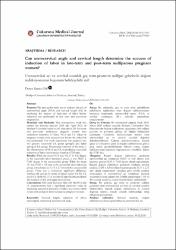| dc.contributor.author | Kanza Gül, Derya | |
| dc.date.accessioned | 2021-02-19T06:40:36Z | |
| dc.date.available | 2021-02-19T06:40:36Z | |
| dc.date.issued | 2020 | en_US |
| dc.identifier.citation | Kanza Gül, D. (2020). Can uterocervical angle and cervical length determine the success of induction of labor in late-term and post-term nulliparous pregnant women? Cukurova Medical Journal, 45(4), 1634-1643. https://dx.doi.org/10.17826/cumj.779429 | en_US |
| dc.identifier.issn | 2602-3032 | |
| dc.identifier.issn | 2602-3040 | |
| dc.identifier.uri | https://dx.doi.org/10.17826/cumj.779429 | |
| dc.identifier.uri | https://hdl.handle.net/20.500.12511/6561 | |
| dc.description.abstract | Purpose: The aim og this study was to evaluate the role of uterocervical angle (UCA) and cervical length (CL) in predicting the success of induction of labor before induction was performed in late term and post-term pregnancies.Materials and Methods: This retrospective study was carried out between January 2018 and April 2020, in Medipol University based on the data about 260 late-term and post-term nulliparous pregnant women who underwent induction of labor. UCA and CL values in pregnant women were assessed just before the induction was performed. Our study population was assigned into two groups: successful IoL group (group1) and failed (group 2) IoL group. The primary outcome of the study is the effectiveness of UCA and CL in predicting successful induction of labor (latent phase duration <= 720 min).Results: While the mean UCA was 102.17 +/- 4.26 degree in the successful labor induction group, it was 94.25 +/- 7.141 degree in the unsuccessful group. While the mean CL was 27.85 +/- 3.5 mm in the successful labor induction group, it was found as 31.73 +/- 2.71 mm in the unsuccessful group. There was a statistically significant difference between the groups in terms of mean values for the CL and UCA. Both the UCA and the CLsignificantly predicted the duration of the prolonged latent phase.Conclusions: This study indicated that both the UCA and CL measurements had a significant predictive value in predicting successful induction of labor and normal birth in late term and post-term nulliparous pregnant women. | en_US |
| dc.description.abstract | Amaç: Bu çalışmada, geç ve post term gebeliklerde indüksiyon yapılmadan önce doğum indüksiyonunun başarısını öngörmede uteroservikal açının (USA) ve servikal uzunluğun (SU) rolünün araştırılması amaçlanmıştır. Gereç ve Yöntem: Bu retrospektif çalışma Ocak 2018Nisan 2020 tarihleri arasında Medipol Üniversitesi Nisa Hastanesinde doğum indüksiyonu uygulanmış 260 nullipar geçterm ve postterm gebeye ait bilgiler kullanılarak yapılmıştır. Gebelerde indüksiyondan hemen önce uteroservikal açı ve servikal uzunluk değerleri değerlendirilmiştir. Çalışma populasyonumuz, başarılı (grup 1) ve başarısız (grup 2) doğum indüksiyonuna göre 2 grup olarak gruplandırılmıştır Birincil sonuç, doğum indüksiyonuna başarısını öngörmekteki etkinliktir. (latent faz ≤720 dk.). Bulgular: Başarılı doğum induksiyon grubunda uteroservikal açı ortalaması 102,17 ± 4,26 derece iken başarısız grupta 94,25 ± 7,141 derece olarak saptanmıştır. Başarılı doğum induksiyon grubunda ortalama servikal uzunluk 27,85 ± 3,5 mm iken başarısız grupta 31,73 ± 2,71 mm olarak saptanmıştır. Gruplara göre serviks uzunluk ortalamaları ve uteroservikal açı ortalaması arasında istatistiksel olarak anlamlı bir farklılık saptanmıştır. USA ve SU) uzamış latent faz süresi önemli ölçüde belirleyicidir. Sonuç: Bu çalışma, geç term ve postterm nullipar gebelerde hem uteroservikal açı hem de servikal uzunluk ölçümlerinin; başarılı doğum indüksiyonu ve normal doğumu tahmin etmede anlamlı belirleyiciliğe sahip olduğunu göstermiştir. | en_US |
| dc.language.iso | eng | en_US |
| dc.publisher | Cukurova University | en_US |
| dc.rights | info:eu-repo/semantics/openAccess | en_US |
| dc.subject | Cervical Length | en_US |
| dc.subject | Induction of Labor | en_US |
| dc.subject | Transvaginal Ultrasound | en_US |
| dc.subject | Uterocervical Angle | en_US |
| dc.subject | Servikal Uzunluk | en_US |
| dc.subject | Doğum İndüksiyonu | en_US |
| dc.subject | Transvaginal Ultrason | en_US |
| dc.subject | Uteroservikal Açı | en_US |
| dc.title | Can uterocervical angle and cervical length determine the success of induction of labor in late-term and post-term nulliparous pregnant women? | en_US |
| dc.title.alternative | Uteroservikal açı ve servikal uzunluk geç term-postterm nullipar gebelerde doğum indüksiyonunun başarısını belirleyebilir mi? | en_US |
| dc.type | article | en_US |
| dc.relation.ispartof | Cukurova Medical Journal | en_US |
| dc.department | İstanbul Medipol Üniversitesi, Tıp Fakültesi, Cerrahi Tıp Bilimleri Bölümü, Kadın Hastalıkları ve Doğum Ana Bilim Dalı | en_US |
| dc.authorid | 0000-0001-8879-9299 | en_US |
| dc.identifier.volume | 45 | en_US |
| dc.identifier.issue | 4 | en_US |
| dc.identifier.startpage | 1634 | en_US |
| dc.identifier.endpage | 1643 | en_US |
| dc.relation.publicationcategory | Makale - Uluslararası Hakemli Dergi - Kurum Öğretim Elemanı | en_US |
| dc.identifier.doi | 10.17826/cumj.779429 | en_US |


















